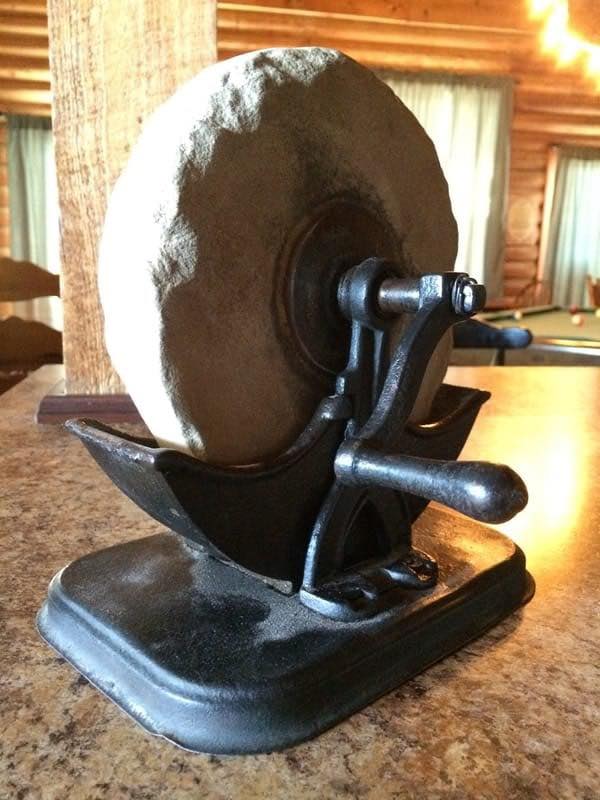In today’s fast-paced, technology-driven world, it’s easy to forget the simple tools that once played a vital role in daily life. One such forgotten gem is the vintage hand-crank sharpening stone, a relic of the past that once lived on every farm, in every workshop, and inside countless sheds. The specific model shown in your photo, stamped with “C S Co”, is not only a tool — it’s a piece of history.
Whether you’re a collector of antique tools, a restoration enthusiast, or someone intrigued by the heritage of craftsmanship, this hand-crank sharpener has a story worth telling.
What Is a Hand-Crank Sharpening Stone?
A hand-crank sharpening stone, also known as a manual grindstone or whetstone sharpener, is a mechanical device used to sharpen blades and tools. Its design is simple but effective: a round abrasive stone is mounted to a rotating spindle, which is powered by a hand crank. As you turn the crank, the stone spins, allowing you to press a blade or tool against it to restore its edge.
These tools were essential before the invention of electric bench grinders. Farmers used them to sharpen scythes. Butchers used them for knives. Carpenters used them for chisels and planes. And households relied on them to keep kitchen blades sharp.
The C S Co. Connection: Who Made This Tool?
The stamp “C S Co” etched into the cast iron likely refers to the Cleveland Stone Company, an Ohio-based manufacturer that operated during the late 19th and early 20th centuries. The company was renowned for its production of high-quality sandstone and sharpening tools, supplying grindstones across North America.
Founded in the mid-1800s, Cleveland Stone Co. specialized in quarrying Berea sandstone — a fine-grained, durable material ideal for sharpening applications. Tools marked with the company’s initials are now considered collector’s items due to their durability and historical value.
Key Features of This Vintage Tool
Let’s take a closer look at the specific features that make this sharpening stone unique:
- Heavy Cast-Iron Base: Designed to be mounted on a workbench or kept stable during use.
- Large Circular Grinding Stone: Often made of natural sandstone or emery, which wears down evenly.
- Hand Crank Mechanism: Allows full manual control over the sharpening speed and pressure.
- Water Trough or Lip: Catches debris or holds water to cool the blade and reduce friction.
These elements combined make this tool not only functional but also a beautifully engineered example of early industrial craftsmanship.
How Old Is This Hand-Crank Sharpener?
Based on the construction materials and manufacturing company, this sharpening stone likely dates between 1880 and 1930. That era was the peak of manually operated grinding tools before electrification brought powered alternatives.
In rural America, tools like this were often passed down from generation to generation, maintained and respected like prized possessions. Today, many of them still work perfectly, a testament to their durable design.
Why Is It Still Relevant Today?
In a time when everything is powered and digital, why should we care about a hand-crank sharpening stone?
1. Sustainability: Unlike electric grinders, this sharpener uses no electricity. It’s eco-friendly, efficient, and long-lasting.
2. Precision: Manual sharpening allows for better control, which is crucial for delicate blades or precision tools.
3. Collectibility: With its historic value and antique design, it’s a standout piece for collectors of vintage tools or Americana.
4. Restoration and DIY Culture: As more people turn to DIY repairs, homesteading, and traditional crafts, vintage tools are making a comeback.
How to Restore and Care for It
If you’ve found or inherited one of these vintage grindstones, here’s how to bring it back to life:
- Clean the Stone: Use a stiff wire brush to remove any debris or rust. Avoid harsh chemicals.
- Check the Bearings: Ensure the crank and axle move smoothly. A little oil can work wonders.
- Test the Stone: Before sharpening, check for cracks. A damaged wheel can be dangerous.
- Secure the Base: Mount it to a sturdy surface or use anti-slip pads.
- Sharpen Responsibly: Always wear eye protection and keep fingers clear of the stone while in use.
Where Can You Find These Today?
Vintage sharpening stones like the one marked “C S Co” can occasionally be found at:
- Estate sales and auctions
- Antique tool fairs
- Online marketplaces (eBay, Etsy, or specialty collector websites)
- Flea markets or barn cleanouts
Prices vary widely, depending on condition, rarity, and completeness. A restored model can fetch anywhere between $50 and $300.
Final Thoughts: More Than Just a Tool
This hand-crank sharpening stone is a beautiful reminder of a time when tools were built to last — when every turn of the crank echoed with patience, skill, and tradition. It’s a tangible piece of history, offering both functionality and a deep connection to the craftsmanship of the past.
Whether displayed on a shelf or put back to work in a workshop, this vintage sharpener proves that some tools never go out of style.


